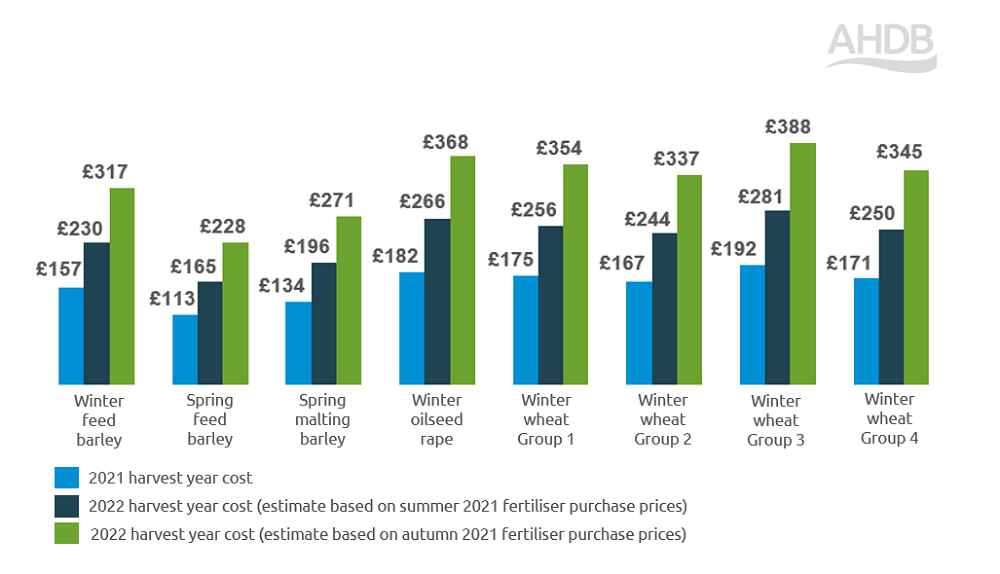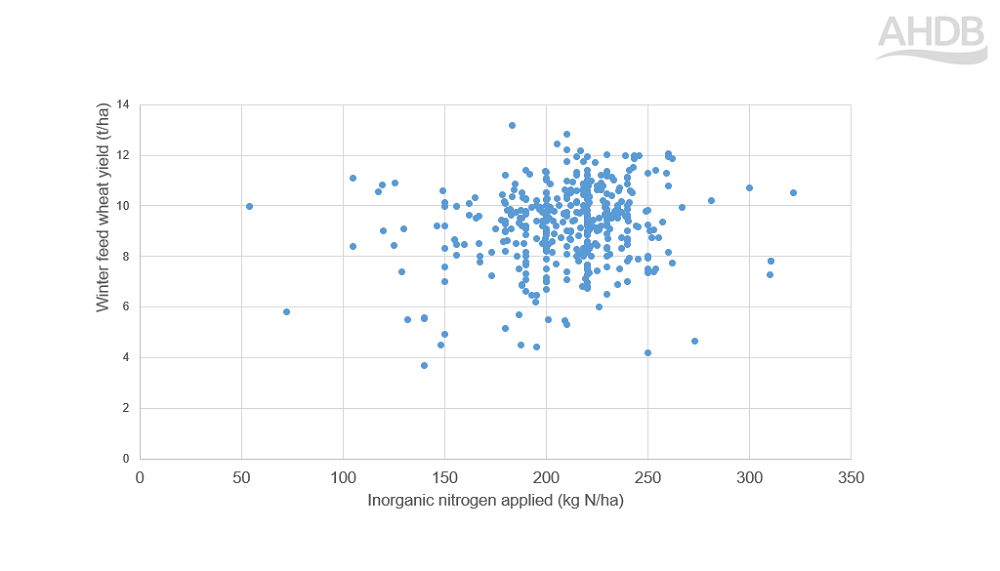Does it pay to cut nitrogen fertiliser?
Friday, 22 April 2022
Mark Topliff, AHDB Lead Analyst – Farm Economics, uses Farmbench data and demonstrates how it can pay to cut inorganic nitrogen fertiliser usage in winter wheat.
In the last 12 months, imported ammonium nitrate (AN) fertiliser prices have more than doubled – with a 191% spike at the end of 2021.
Even fertiliser products such as diammonium phosphate (DAP) experienced a 111% lift in prices compared to the previous 12 months.
 prices (34.5 N).PNG) AHDB
AHDB
Figure 1. Trends in imported ammonium nitrate (AN) prices (34.5% N)
Production cost pressures
Naturally, elevated prices impact production costs (Figure 2).
For example, if you apply autumn 2021 inorganic fertiliser prices to application rates used for harvest 2021 crops, then costs would be up to £200/ha higher.
Even if purchased for a lower price in summer 2021, the cost increase would still be around £70–£80/ha.
 AHDB
AHDB
Figure 2. How higher nitrogen prices could impact production costs. 2021 costs based on AHDB Farmbench results. 2022 estimates based on Defra agricultural indices and AHDB fertiliser survey findings applied to Farmbench 2021 results (assumes no change to nitrogen application rates)
Nitrogen and yield
Farmbench results indicate a weak association between the amount of inorganic nitrogen applied and wheat yields (Figure 3).
At a typical application rate of 220 kg N/ha, yield differences of around 6 t/ha were reported.
Understanding this variation could help people use nitrogen more effectively.
 AHDB
AHDB
Figure 3. The weak relationship between wheat yield and total inorganic nitrogen applied. Based on 405 Farmbench results (2018–21) for conventional first winter feed wheat on clay loam soils
Farmbench figures from first winter feed wheat reveal differences between the top and bottom 25% groups of farmers (Table 1).
The top 25% achieved higher yields with less inorganic nitrogen per tonne of grain produced. They also spent less on fertilisers, with a higher use of organic fertilisers – which may have contributed to the success of this group.
Table 1. Fertiliser and yield figures for the top and bottom 25% groups of farmers (ranked on net margin performance). Based on 405 Farmbench results (2018–21) for conventional first winter feed wheat on clay loam soils
|
Fertiliser or yield measure |
Top 25% |
Bottom 25% |
Difference Top to bottom |
|
Yield (t/ha) |
10.2 |
8.5 |
+1.7 |
|
Inorganic N applied (kg N/ha) |
214 |
201 |
+13 |
|
Inorganic N:yield ratio (kg N/ha:t/ha) |
21 |
24 |
-3 |
|
Total fertiliser cost* (£/ha) |
188 |
198 |
-10 |
|
Inorganic fertiliser (% of cost) |
92 |
93 |
-1 |
|
Organic fertiliser (% of cost) |
4 |
2 |
+2 |
|
Trace elements (% of cost) |
4 |
5 |
-1 |
*Total fertiliser cost includes the cost of inorganic, organic fertilisers, and trace elements
Nitrogen: how low can you go?
The nitrogen recommendations in the AHDB Nutrient management guide (RB209) are based on the economic optimum, which can be calculated using the break-even ratio (BER) – the extra yield needed to pay for one kilogram of nitrogen fertiliser.
Based on current grain and fertiliser prices, the typical BER for cereals is around 9.7:1 – 9.7 kg of grain needed to pay for 1 kg of nitrogen fertiliser. For oilseeds, the typical BER is around 3.6:1.
However, as bought fertiliser prices and grain or oilseed prices (expected or received) vary considerably, it is important to estimate the BER for each unique situation.
BER example
Fertiliser price (AN): £785/tonne
Expected winter wheat price: £275/tonne
BER: 8.3:1
- Using this BER, the recommended reduction in nitrogen would be 35 kg/ha (saving £80/ha)
- The estimated yield reduction would be 0.23 t/ha (losing £63/ha)
- The difference between cost saved and income lost is a gain of £17/ha
In this scenario, it would pay to reduce inorganic nitrogen fertiliser rates.
Nitrogen fertiliser adjustment calculator
AHDB has published a calculator to help with the estimation of the BER. It also suggests an adjustment to the RB209 recommended nitrogen fertiliser rate.
Simply enter the fertiliser price and the nitrogen content, in addition to the grain or oilseed price.
Additionally, enter your typical application rate and crop area for more results on the nitrogen requirements for your situation.
Topics:
Sectors:
Tags:

